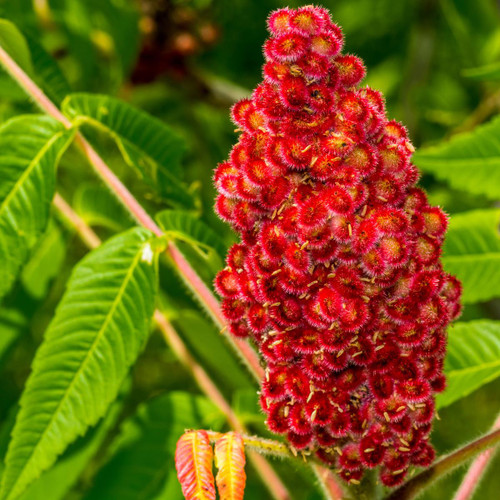Landscaping With Staghorn Sumac
North American landscapes have featured Staghorn Sumac, or Rhus typhina, for thousands of years due to its ancient origins. Native peoples held this plant in high regard because they used it extensively for healing purposes as well as cooking and everyday necessities. European settlers who first arrived in North America found it's value quickly apparent and adopted its use into their own cultural practices. Throughout many centuries, it expanded into different habitats where it successfully lived in a broad range of natural environments, from open woodlands to rocky hillsides. The historical archives show that Indigenous peoples passed on the plant to the early European settlers which underscores its importance in both ecological and cultural narratives.
Staghorn Sumac Medicinal Uses Through Time
Rhus typhina has served as a fundamental element in natural medicine for many centuries. Indigenous healers prepared medicinal decoctions from its bark and roots which helped combat fevers and digestive problems. People steeped berries rich in vitamin C and antioxidants into teas, which helped soothe sore throats and strengthen the immune system. The astringent qualities of this plant's leaves made them effective for wound healing when used as poultices. Today's herbalists investigate its potential advantages for enhancing immune function along with reducing inflammation. Researchers continue to study this plant because of its possible medicinal uses which align with traditional natural healing practices.

Discovery and Early Documentation
The earliest known interactions with Rhus typhina happened in Indigenous settlements during which its applications were extensively recorded through oral traditions. In the 17th century, European botanists started to formally document the plant because of its exceptional adaptability and its striking visual characteristics. The plant's resilience and adaptability across different landscapes had been widely acknowledged before scientific classifications expanded throughout the 19th century. During this time scientists studied its distinctive anatomy and seasonal changes which resulted in its botanical classification.
Staghorn Sumac A Bold Presence in Landscaping
Landscapers and garden lovers choose Staghorn Sumac as their preferred plant because of its remarkable visual appeal. The tree's expansive feathery leaves transform into brilliant hues of orange, red and gold during autumn months which results in a stunning visual show. In gardens and naturalized landscapes, designers use this plant as a decorative highlight to maintain visual interest throughout the year. Its tree-like structure with gracefully curving branches makes it perfect for stabilizing slopes and disturbed ground against erosion. With its ability to survive drought and thrive in poor soils, this plant has become essential for sustainable landscaping projects that demand both aesthetic appeal and resilience.
Staghorn Sumac A Striking Visual Specimen
The Staghorn Sumac is one of the few plants capable of such dramatic seasonal changes. During the spring and summer months the plant displays lush green foliage with finely divided leaflets that create a soft feathery appearance. When the weather gets colder the plant's leaves transform into stunning fiery colors which create a beautiful autumn scene. The branches support clusters of velvety red fruit that take a cone shape and stand out against the backdrop of changing leaves. The plant maintains visual interest during winter with its complex branching pattern and rust-toned fruit clusters against barren landscapes. The plant's unique character is amplified by its fuzzy-textured stems which add to its visual charm.
A Haven for Rare Wildlife
Staghorn Sumac provides essential habitat support for wildlife along with its decorative features. Birds depend on the plant's nutrient-packed berries as a fundamental food supply when food scarcity occurs in winter. Robins, bluebirds, and waxwings depend on this fruit to sustain their lives. The plant's flowers draw numerous pollinators like bees and butterflies which helps maintain biodiversity. Through its dense growth pattern this plant creates habitats for small mammals and avian nesting sites which makes it indispensable for natural ecosystems. The plant supports a wide range of wildlife, which demonstrates its ecological importance in rural and urban environments.